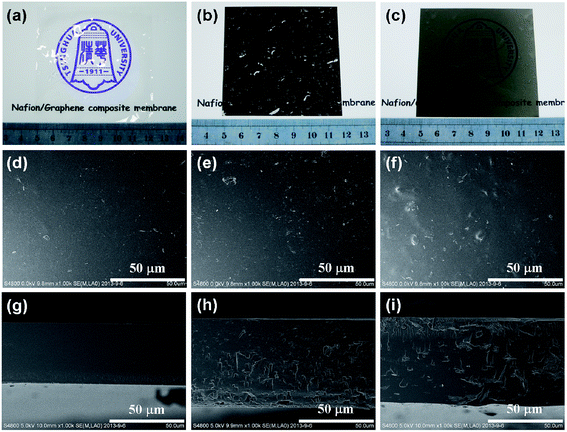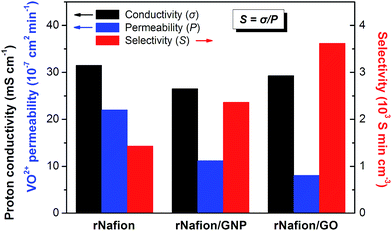A recast Nafion/graphene oxide composite membrane for advanced vanadium redox flow batteries
Lihong Yua,
Feng Lina,
Ling Xua and
Jingyu Xi*b
aSchool of Applied Chemistry and Biological Technology, Shenzhen Polytechnic, Shenzhen 518055, China
bInstitute of Green Chemistry and Energy, Graduate School at Shenzhen, Tsinghua University, Shenzhen 518055, China. E-mail: xijy@tsinghua.edu.cn
First published on 23rd December 2015
Abstract
A graphene oxide (GO) nanosheet incorporated recast Nafion membrane (rNafion/GO) is applied to a vanadium redox flow battery (VRFB) as a promising ion-exchange membrane to reduce the vanadium permeation. Randomly embedded GO nanosheets in the composite membrane can serve as effective barriers to block the transport of vanadium ions, resulting in significant decrease of vanadium ion permeability. The rNafion/GO composite membrane exhibits a dense and homogeneous cross-section morphology as shown by SEM images. The hydrogen-bonding interaction between GO nanosheet filler and Nafion matrix is beneficial for the improvement of mechanical stability. Owing to the good balance of proton conductivity and vanadium ion permeability, the VRFB single cell performance of the rNafion/GO membrane shows higher coulombic efficiency (96% vs. 91%) and energy efficiency (85% vs. 80%) than the pure rNafion membrane at a current density of 80 mA cm−2. A long cycling test confirms that the rNafion/GO membrane has superior chemical and mechanical stability and can be repeatedly used in a VRFB without any damage, revealing the advancement for practical VRFB application.
1. Introduction
The essential challenge of solar and wind energy is how to store it, due to their intermittent and volatile features and low-quality electricity output.1–3 From medium to large-scale energy storage, vanadium redox flow batteries (VRFB) have many benefits over other energy storage systems regarding low environmental impact, long lifespan, fast response and flexible design, making them become one of the most promising technologies for integrating electricity from various renewable energy sources into the grids.4–10As the key component to separate the positive and negative electrolytes while transporting protons to complete the electrical circuit in VRFB, the ion-exchange membrane (IEM) greatly decides the performances (both cyclability and efficiency) of VRFB and can cost up to 30–50% of the whole battery system.11–13 Thus, there is no wonder that countless researchers all over the world focus on investigating, searching and developing the suitable membranes for VRFB, which provides good performance but low cost. Other than the low cost, an ideal IEM of VRFB should also possess high proton conductivity, low vanadium ion permeability, excellent stability, and high mechanical strength.14 Currently, perfluorinated sulfonic acid membranes such as Nafion membranes are the most frequently used membranes in VRFB owing to their excellent proton conductivity and superior chemical and mechanical stability.14–17 Nafion's good proton conductivity resides in its well-developed water channels under fully hydrated state.18 However, these water channels may also allow vanadium ions to migrate through the membrane, which results in lower battery efficiency and faster capacity fading of the VRFB.14–17 In addition, the high cost (500–700 US dollars per m2) of Nafion membrane also limits the commercial progress of VRFB.17 In the past decade, the research attention has ever been shifted to seeking the alternatives non-perfluorinated membranes, such as sulfonated poly(ether ether ketone), sulfonated poly(fluorenyl ether ketone), sulfonated poly(aryl ether sulfone ketone), sulfonated poly(aryl ether sulfone) and sulfonated poly(imide).16,19–21 Non-perfluorinated anion exchange membranes (AEM)22,23 and porous structured nanofiltration membranes24,25 have also been investigated towards VRFB application. The non-perfluorinated membranes may win in low cost and vanadium ion permeability, but would lose in mechanical and chemical stability under the strong acid and oxidizing VRFB medium.26–28 As all aspects considered, although expensive, the Nafion membrane is still the best choice for most large scale VRFB energy storage systems due to its extremely chemical stability. Therefore, decreasing the cost (by using ultrathin membrane)29,30 and improving the ionic selectivity (by the strategy of organic–inorganic hybrid or surface modification)31–34 of Nafion based membrane would maintain an important research focus for a long period of time ahead.
GO, known as an excellent two-dimensional layer structure material, has high specific surface area and intrinsic mechanical stability with various oxygen functional groups on the surface of the graphite basal planes and sheet edges such as hydroxyl, carboxyl acid, epoxy and ketone.35 Similar to inorganic fillers, GO and its derivatives were often used as fillers for polymer composites, and their composites are known to exhibit good electrochemical and mechanical properties.36 In this study, GO nanosheets were uniformly filled in the recast Nafion matrix forming a composite membrane denoted as rNafion/GO. The unique two-dimensional structure and the oxygen functional groups of GO nanosheets make it compatibility well with Nafion matrix and IEM properties in the VRFB system could be improved. Water uptake, proton conductivity and vanadium ion permeability of the membranes were studied to evaluate the membrane properties. The vanadium ion permeability of rNafion/GO membrane was greatly decreased compared to rNafion (pure recast Nafion) membrane and rNafion/GNP (recast Nafion/graphene nanoplate) membrane. The VRFB assembled with the rNafion/GO composite membrane exhibited highest cell performances among the three membranes. Long cycling test confirmed that rNafion/GO membrane has superior chemical and mechanical stability and can be repeatedly used in VRFB without any damage.
2. Experimental
2.1 Materials
GO nanosheets (GO, XF002) and graphene nanoplate (GNP, XF022) were supplied by Nanjing XFNANO Materials Tech Co. Ltd. All chemicals were analytical grade and used without further purification.2.2 Membrane preparation and morphology
The Nafion resin was prepared from used Nafion 117 membrane according to the hydrothermal method reported by Teng et al.37,38 The recast Nafion/graphene oxide composite membrane (rNafion/GO) was prepared using the conventional solution casting method. Briefly, 1.5 g of Nafion resin was dissolved in 6 mL DMF and 15 mg of GO was dispersed in 4 mL DMF under sonication for 1 h to form a stable suspension. The GO suspension was transferred to the Nafion solution under vigorous mechanical stirring for 24 h. The resulting mixture was cast onto flat clean glass and dried at 60 °C for 12 h and then at 140 °C under vacuum for another 12 h. After cooled to room temperature, the membrane was peeled off from the glass and soaked in 1 M H2SO4 for 24 h. Subsequently, the membrane was immersed into deionized water for 24 h to remove the excess acid and stored in deionized water for further use. For comparison, pure recast Nafion membrane (rNafion) and Nafion/graphene nanoplate composite membrane (rNafion/GNP) were prepared and treated under the same procedure.The morphology of membrane cross-sections were observed by a Hitachi S-4800 scanning electron microscope (SEM). For viewing the membrane cross-sections, the samples were prepared by fracturing the membranes in liquid nitrogen and subsequently coated with Au.
2.3 Membrane characterization
To evaluate the water uptake and swelling ratio of membranes, membrane samples were firstly soaked in deionized water at room temperature for 24 h, and then wiped with absorbent paper to remove the surface water before measurement. Afterwards, the membranes were dried in vacuum oven at 100 °C for 24 h. The water uptake and swelling ratio of the membrane were calculated according to the following equations:
 | (1) |
 | (2) |
The ion exchange capability (IEC) of the membrane was measured by traditional titration. Typically, the membranes were first dried and the weights were recorded. Subsequently, the membranes were soaked in 50 mL saturated NaCl solution for 24 h. Afterwards, the solution was back titrated with 0.1 M NaOH. IEC was calculated according to the following equation:
 | (3) |
The proton conductivity of sample membranes was measured by electrochemical impedance spectroscopy (EIS) using a PARSTAT 2273 electrochemical station.
The VO2+ permeability through the membrane was measured with the method described in the ref. 31. The membrane (effective area of 7 cm2) was sandwiched between two diffusion half cells, as shown in the inset of Fig. 2. The left reservoir was filled with 40 mL of 1.5 M VOSO4 in 3 M H2SO4 solution and the right one was filled with 40 mL of 1.5 M MgSO4 in 3 M H2SO4 solution. The two solutions were continuously magnetically stirred to avoid the concentration polarization. The concentration of VO2+ in the right reservoir was monitored as a function of time using a UV-Vis spectrophotometer (Leng Guang 752S). The ion selectivity of membrane (S) is defined as the ratio of the proton conductivity and the VO2+ permeability.
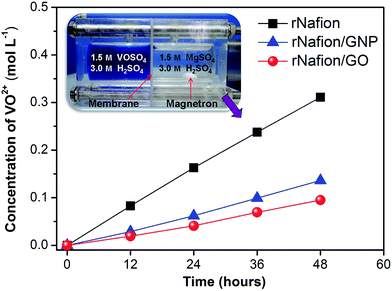 | ||
| Fig. 2 Time-dependent concentration changes of VO2+ in MgSO4 solution across the membrane. Inset is the photograph of the membrane-separated diffusion cell. | ||
Tensile measurements on the membranes (10 mm × 50 mm) were carried out using a universal test machine (SANS, CMT6104) with a programmed elongation rate of 2 mm min−1. For each membrane, three measurements were conducted and the average value was recorded.
2.4 VRFB single cell performance
The VRFB single cell was assembled by sandwiching a membrane (70 mm × 70 mm, as shown in Fig. 1) with two graphite felt electrode (50 mm × 50 mm × 5 mm, thermal activated in air at 420 °C for 10 h), and two graphite polar plates served as current collectors.39,40 Two 50 mL of 2 M VO2+/V3+ (1![[thin space (1/6-em)]](https://www.rsc.org/images/entities/char_2009.gif) :
:![[thin space (1/6-em)]](https://www.rsc.org/images/entities/char_2009.gif) 1) in 2 M H2SO4 solution, serving as the starting negative and positive electrolytes, were cycled using peristaltic pumps with a flow rate of 60 mL min−1. The cell was charged and discharged using a battery testing system (CT-3008W-5V6A, Neware). The upper limit of charge voltage and the lower limit of discharge voltage were 1.65 V and 0.8 V, respectively. The digital photo of some VRFB single cells was shown in Fig. 4(a). For the cell efficiency, 5 cycles at each current density were run and the average values were given.
1) in 2 M H2SO4 solution, serving as the starting negative and positive electrolytes, were cycled using peristaltic pumps with a flow rate of 60 mL min−1. The cell was charged and discharged using a battery testing system (CT-3008W-5V6A, Neware). The upper limit of charge voltage and the lower limit of discharge voltage were 1.65 V and 0.8 V, respectively. The digital photo of some VRFB single cells was shown in Fig. 4(a). For the cell efficiency, 5 cycles at each current density were run and the average values were given.
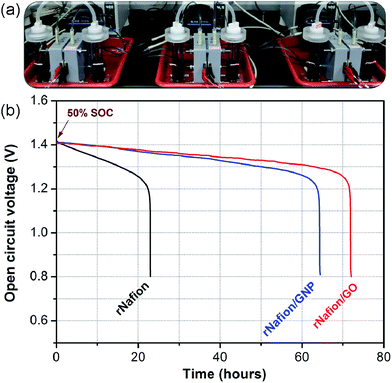 | ||
| Fig. 4 (a) Photograph of VRFB single cells. (b) Self discharge curves of VRFBs assembled with rNafion, rNafion/GNP and rNafion/GO membranes. | ||
3. Results and discussion
The macro and micro morphology of the three homemade recast membranes were carefully investigated. Fig. 1 shows the surface and the cross-sectional images of the rNafion, rNafion/GNP and rNafion/GO membranes obtained by digital camera and SEM analysis. It is clearly shown that all the three membranes are homogeneous, compact and transparent. Pure rNafion membrane is colorless, whereas the color of the composite membrane turns to brown when GO is incorporated in the Nafion matrix, and dark when GNP is added, as illustrated in Fig. 1(a)–(c). From the SEM images in Fig. 1(d)–(f), it is seen that the surface of rNafion is well-distributed and smooth under microscope, while some clusters can be found on the surface of rNafion/GNP and rNafion/GO membranes due to the introduction of the GNP and GO nanosheets into the Nafion matrix. From the cross-section SEM images of the three membranes as shown in Fig. 1(g)–(i), distinct differences are observed, that the pure rNafion membrane presents a very smooth cross section, while the rNafion/GNP and rNafion/GO membranes display a relatively rough cross-section where the fractured nanosheets of GNP and GO can be observed in the Nafion matrix. GNP and GO nanosheets are randomly dispersed into the Nafion matrix due to interfacial interactions between them and Nafion matrices.Physicochemical properties including ion exchange capability (IEC) and proton conductivity of all three membranes are listed in Table 1. As shown in Table 1, in aspects of water uptake, swelling ratio and IEC, the rNafion/GO membrane is superior to the rNafion membrane, while the rNafion/GNP membrane is inferior to the rNafion membrane, which may be due to that the oxygen containing groups in GO benefit its compatibility with Nafion, but GNP has no such oxygen containing groups. The hydrophilic nature of GO can help maintain the hydrophilicity and retention of water molecules in the composite membranes. However, the proton conductivity of both rNafion/GNP and rNafion/GO membranes is lower than rNafion because of the blocking effect of the GNP and GO filler. Proton conductivity is an overall outcome of the following matters: (1) high water uptake can facilitate proton migration,41 (2) GO itself can provide a proton transport pathway via hydrogen-bonding diffusion,42 (3) the blocking effect of GNP and GO nanosheets with large surface area could decrease the proton conductivity of the composite membranes. Nevertheless, despite the lower proton conductivity compared to rNafion membrane, filling GNP and GO nanosheets in recast Nafion membrane actually increase its VRFB cell performance, which is verified by the following results.
| Samples | Thickness (wet, μm) | Water uptake (%) | Swelling ratio (%) | IEC (mmol g−1) | Proton conductivity (mS cm−1) | Breaking strength (MPa) | Percentage elongation (%) |
|---|---|---|---|---|---|---|---|
| rNafion | 58 | 27.0 | 16.3 | 0.85 | 31.5 | 17.1 | 81 |
| rNafion/GNP | 67 | 24.2 | 14.8 | 0.81 | 26.5 | 17.7 | 76 |
| rNafion/GO | 70 | 27.5 | 17.1 | 0.88 | 29.3 | 19.2 | 73 |
VO2+ permeability was tested by a home-made device and the concentration of VO2+ in MgSO4 solution across the membranes as a function of time is shown in Fig. 2. The VO2+ permeability of the rNafion/GNP and rNafion/GO membranes is much lower than that of the rNafion membrane through all the test time due to their different membrane microstructures. The microstructure of the rNafion/GNP and rNafion/GO membranes has less channels of VO2+ than the rNafion membrane due to the incorporation of GNP and GO nanosheets. The two-dimensional layered GNP and GO nanosheets serve as effective barriers to prevent vanadium ions from migrating through the membrane. To bypass the GNP and GO nanosheets in the Nafion matrix, VO2+ has to travel a prolonged pathway due to the significant increase of tortuosity, which reduces the VO2+ permeability. Compared to GNP, the interfacial interaction between GO and Nafion matrix restricts the formation of hydrophilic channels43 used for the transport of vanadium ions, which enables rNafion/GO membrane a lower vanadium ion permeability than rNafion/GNP. Generally, selectivity is a comprehensive factor for evaluating the membrane performance defined as the ratio of proton conductivity over vanadium ion permeability, and a higher selectivity value indicates better performance in VRFB.14
Proton conductivity, VO2+ permeability and ion selectivity of rNafion, rNafion/GNP and rNafion/GO membranes are compared in Fig. 3. The conductivity of all the three membranes is comparable, while in aspect of the permeability, the value of rNafion/GO membrane is clearly less than rNafion and rNafion/GNP membranes. Consequently, rNafion/GO membrane shows obviously highest selectivity among the three membranes. It is expected that VRFB assembled with rNafion/GO membrane would illustrate the best cell performance among the three, which will be verified by the following single cell investigations.
To confirm the property trend of the three homemade recast membranes, the self-discharge test was conducted. Fig. 4 illustrates digital photos (up) of the assembled VRFB single cells with the rNafion, rNafion/GNP and rNafion/GO membranes and their self discharge curves (down) starting from 50% state of charge (SOC). The open circuit voltage (OCV) of all the three single cells gradually decreased firstly and then sharply dropped to 0.8 V. The time of the cell discharge to 0.8 V are 23 h, 64 h, and 72 h for rNafion, rNafion/GNP and rNafion/GO, respectively. The OCV decay rate for rNafion/GNP and rNafion/GO membranes was much lower than rNafion membrane. This result is consistent with the VO2+ permeability and ion selectivity trend. It is clear that rNafion/GO membrane, with the lowest vanadium ion permeability and the highest ion selectivity, demonstrates the longest charge retention time among the three membranes.
With proton conductivity slightly sacrificed, the VO2+ permeability of the composite rNafion/GO membrane is greatly decreased by filling GO nanosheets due to the changed microstructure. Since VO2+ is bigger in radius than proton, its traveling path in the micro channels must be altered in the rNafion/GO membrane compared to the pure rNafion membrane. Fig. 5 shows the proposed mechanism for proton transport and vanadium ions permeation process in rNafion/GO composite membrane. Vanadium ion can transport comparatively freely in the pure rNafion membrane through the water channels. When filling GO nanosheets in Nafion matrix, the inter-planar space dimension is shrunk due to the interaction between the oxygen-containing groups on GO and the sulfonated acid groups of Nafion matrix in the composite membrane. Besides, the randomly embedded GO nanosheets in the composite membrane by themselves are effective barriers to prevent the transport of vanadium ion. Consequently, the VO2+ permeability of the composite rNafion/GO membrane is greatly reduced. On the other hand, rNafion/GO composite membrane has more branched and tortured water channels which may slightly impede the proton to transport and thereafter the proton conductivity is also decreased to some extend. Conclusively, the equilibrium should be found since that the addition of GO may lower the vanadium ion permeability while the tortured pathway of water channels may also reduce the proton conductivity slightly.
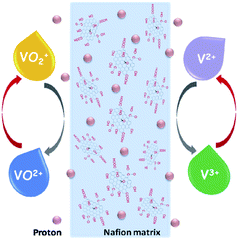 | ||
| Fig. 5 Proposed mechanism for proton transport and vanadium ions permeation process in rNafion/GO composite membrane. | ||
Mechanical properties of the membranes were test to further confirm the interaction between the Nafion matrix and the nanosheet fillers. It can be seen from Table 1 that both rNafion/GNP and rNafion/GO composite membranes exhibit higher breaking strength and lower percentage elongation than that of pure rNafion membrane. The result indicates that the incorporation of GNP and GO nanosheets into Nafion matrix can enhance the mechanical strength of the composite membrane owing to the hydrogen-bonding interaction between oxygen-containing groups on nanosheet fillers and sulfonated acid groups of Nafion matrix. In addition, rNafion/GO membrane shows better mechanical properties than rNafion/GNP membrane, which can be explained by the much more oxygen-containing groups on GO than that of GNP.35,36
Performance of the assembled real single cell is a typical way to examine how well the IEM works. Fig. 6 shows the charge–discharge curves of VRFBs assembled with rNafion, rNafion/GNP and rNafion/GO membranes, obtained at the current densities of 80 mA cm−2. Both the charge and discharge capacities of VRFB cells with the membranes demonstrate a trend of rNafion/GO > rNafion/GNP > rNafion. The three membranes show close charge curves indicating that GO and GNP incorporation has no big influence on the charge process of the single cell. However, the capacity loss in the discharge process is obviously different among the three membranes and rNafion/GO based cell provides the highest discharge capacity. This is ascribed to the lower vanadium ion permeability of the rNafion/GO membrane compared to pure rNafion and rNafion/GNP membrane.
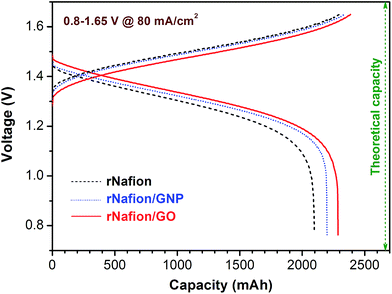 | ||
| Fig. 6 Charge–discharge curves of VRFBs assembled with rNafion, rNafion/GNP and rNafion/GO membranes. | ||
To further investigate the performance of the composite membranes in VRFB, the VRFBs assembled with all the aforementioned membranes were run under various current density conditions. The profiles of coulombic efficiency (CE) and energy efficiency (EE) as functions of current density are illustrated in Fig. 7. The deviation of efficiency value was less than 0.5% in the charge–discharge test. Due to the identical configuration of VRFB single cell except membrane, CE was dominantly affected by the cross-mixing of vanadium ions.40 In this experiment, CE for the three membranes has an order of rNafion/GO > rNafion/GNP > rNafion within current densities of 40–200 mA cm−2, in accordance with the results of VO2+ permeability (Fig. 2). The increasing of CE with current density could be attributed to shorter charge–discharge time at higher current density, resulting in lower cross-mixing of vanadium ions and capacity loss.14,17 The order of EE was the same as shown in the charge–discharge curves, where the composite membranes exhibits higher EE than pure rNafion membrane. The gradual decreasing of EE with the increasing of current density could be assigned to the increasing of ohmic polarization of the cell. Owing to the good balance of proton conductivity and vanadium ion permeability, rNafion/GO membrane showed highest EE within these membranes at all current densities. The VRFB single cell performance of rNafion/GO membrane shows higher CE (96% vs. 91%) and EE (85% vs. 80%) than pure rNafion membrane at current density of 80 mA cm−2, revealing the advancement for practical VRFB application.
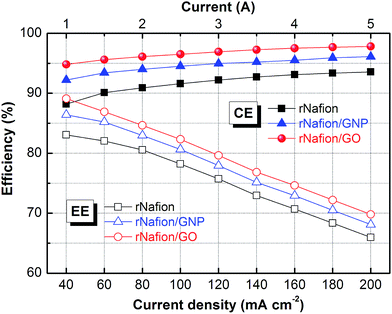 | ||
| Fig. 7 Coulombic efficiency (CE) and energy efficiency (EE) of VRFBs assembled with rNafion, rNafion/GNP and rNafion/GO membranes under different current densities. | ||
Lee et al. have also reported an optimized Nafion-0.01 wt% GO composite membrane to improve the performance of the VRFB.44 However, compared to our results, their composite membranes are not even where many clusters of GO can be seen and a maximum EE value of 82.5% was moderate. This may be due to the following reasons: (1) the GO solution they used is too high in concentration (10 mg mL−1) while the Nafion solution is too low in concentration (5 wt%) and therefore during the evaporation process GO would unite and precipitate; (2) the solvent of commercial Nafion solution is a mixture of water and isopropanol which is not suitable for casting Nafion membrane. Instead, a high-boiling-point solvent DMF should be used for casting a membrane, followed by a thermal aging process.37,38 In this way, a good structured rNafion and rNafion/GO composite membrane could be obtained, just like the treatment in our experiment. The even membranes and the superior performances of the rNafion/GO composite membranes in our work can be clearly seen in Fig. 1 and 7, respectively.
It is essential to investigate the stability of rNafion/GO composite membrane under strong oxidizing and acidic conditions. The VRFB single cell was assembled and run continuously for 200 cycles and then the single cell was disassembled, cleaned and reassembled once again, after which another 200 cycles test was run. The cycling performance of the single cell assembled with rNafion/GO membrane in the two rounds of 200 cycles charge–discharge test was shown in Fig. 8. The CE of the single cell with rNafion/GO membrane remained nearly constant during the two rounds of 200 cycles. The decline of EE is negligible from 85% to 82% after 200 cycles. This indicates that the rNafion/GO composite membrane could effectively resist the degradation under the severe VRFB operation. It is found that the CE and EE profiles of the 2 rounds of 200 cycles test overlap with each other completely, which implies that the rNafion/GO composite membrane possesses a superior chemical stability in vanadium solutions and it can be repeatedly used without any damage.
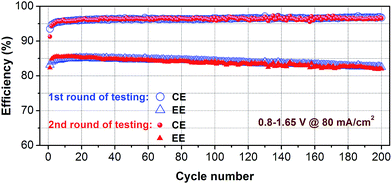 | ||
| Fig. 8 Cycling performance of VRFB assembled with rNafion/GO membrane in two rounds of 200 cycles charge–discharge test. | ||
Fig. 9 displays the discharge capacity of VRFBs assembled with rNafion/GO membrane and rNafion membrane over 200 cycles charge–discharge tests at 80 mA cm−2. The discharge capacity of VRFB with rNafion/GO membrane is higher than that of rNafion membrane during all 200 cycles test. The capacity fading rate of rNafion/GO membrane is slower than that of rNafion membrane, which can be explained by the suppressed vanadium ion permeability by GO incorporation (see Fig. 2 and 5). After 200 cycles, the discharge capacity retention of VRFB with rNafion/GO membrane is higher than the one with rNafion membrane by 76.6% versus 62.1%.
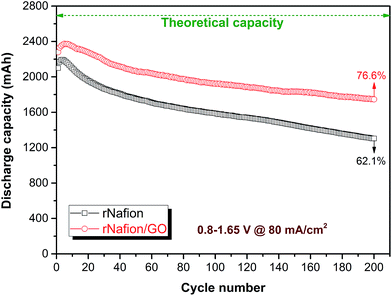 | ||
| Fig. 9 Discharge capacity of VRFBs assembled with rNafion and rNafion/GO membrane in 200 cycles charge–discharge test. | ||
The dense and homogeneous surface and cross-section morphology of rNafion/GO membrane after usage was observed by SEM. Fig. 10 shows the photograph of rNafion/GO membrane after the first sequence of 200 cycles running and its SEM images of the surface and cross-section morphology after the second sequence of 200 cycles running. As shown in Fig. 10(a), the rNafion/GO membrane is intact after first 200 cycles charge–discharge running which is confirmed by the cycling performance results in Fig. 8. After the second sequence of 200 cycles running, rNafion/GO membrane was disassembled and investigated under microscope. There are no observable holes or cracks in the surface or the cross-section area of rNafion/GO membrane as shown in Fig. 10(b) and (c). These results confirm that rNafion/GO membrane has superior chemical and mechanical stability and can be repeatedly utilized in VRFB without any damage.
The static oxidation stability of rNafion and rNafion/GO membranes were further investigated by soaking membranes (15 × 50 mm) in high concentration V(V) solutions (1.5 M V(V) + 3 M H2SO4) for 2 weeks. The chemical degradation of membrane could be due to the degradation of membrane backbone. Hence the V(IV) reduced from V(V) indicates the stability of membrane.40 Notably, both rNafion and rNafion/GO membranes show extremely low weight loss (<0.2 wt%) and V(IV) reduced from V(V) (<0.1%), revealing the outstanding static oxidation stability in the high concentration V(V) solutions.
4. Conclusions
Recast Nafion/graphene oxide (rNafion/GO) and Nafion/graphene nanoplate (rNafion/GNP) composite membranes were fabricated and successfully used in VRFB. The uniformly dispersed GO (GNP) nanosheets in Nafion matrix act as a physical barrier to prevent the vanadium ions from cross-mixing, resulting in lower vanadium ion permeability and higher ion selectivity of the composite membrane. The hydrogen interaction between GO filler and Nafion matrix is beneficial for the improvement of mechanical stability. Consequently, higher cell efficiency and superior cycling stability are obtained in VRFB with rNafion/GO composite membrane compared with the pure recast Nafion membrane. Further improvements in the performance of rNafion/GO could be achieved by optimizing the GO contents (or surface functional group) and membrane thickness.Acknowledgements
This work was supported by the National Natural Science Foundation of China (21576154), Natural Science Foundation of Guangdong Province (2015A030313894) and Basic Research Project of Shenzhen City (JCYJ20150630114140630, JCYJ20150331151358143 and JCYJ20130402145002403).Notes and references
- B. Dunn, H. Kamath and J. M. Tarascon, Science, 2011, 334, 928 CrossRef CAS PubMed.
- Z. Yang, J. Zhang, M. C. W. Kintner-Meyer, X. Lu, D. Choi, J. P. Lemmon and J. Liu, Chem. Rev., 2011, 111, 3577 CrossRef CAS PubMed.
- N. Savage, Nature, 2015, 526, S98 CrossRef CAS PubMed.
- M. Skyllas-Kazacos, M. H. Chakrabarti, S. A. Hajimolana, F. S. Mjalli and M. Saleem, J. Electrochem. Soc., 2011, 158, R55 CrossRef CAS.
- A. Parasuraman, T. M. Lim, C. Menictas and M. Skyllas-Kazacos, Electrochim. Acta, 2013, 101, 27 CrossRef CAS.
- K. J. Kim, M. S. Park, Y. J. Kim, J. H. Kim, S. X. Dou and M. Skyllas-Kazacos, J. Mater. Chem. A, 2015, 3, 16913 CAS.
- C. Ding, H. Zhang, X. Li, T. Liu and F. Xing, J. Phys. Chem. Lett., 2013, 4, 1281 CrossRef CAS PubMed.
- J. Noack, N. Roznyatovskaya, T. Herr and P. Fischer, Angew. Chem., Int. Ed., 2015, 54, 9776 CrossRef CAS PubMed.
- G. L. Soloveichik, Chem. Rev., 2015, 115, 11533 CrossRef CAS PubMed.
- W. Zhang, J. Xi, Z. Li, H. Zhou, L. Liu, Z. Wu and X. Qiu, Electrochim. Acta, 2013, 89, 429 CrossRef CAS.
- R. V. Noorden, Nature, 2014, 507, 26 CrossRef PubMed.
- H. Zhang, Nature, 2014, 508, 319 CrossRef PubMed.
- B. R. Chalamala, T. Soundappan, G. R. Fisher, M. R. Anstey, V. V. Viswanathan and M. L. Perry, Proc. IEEE, 2014, 102, 976 CrossRef CAS.
- X. Li, H. Zhang, Z. Mai, H. Zhang and I. Vankelecom, Energy Environ. Sci., 2011, 4, 1147 CAS.
- H. Prifti, A. Parasuraman, S. Winardi, T. M. Lim and M. Skyllas-Kazacos, Membranes, 2012, 2, 275 CrossRef CAS PubMed.
- N. L. Doan, T. K. A. Hoang and P. Chen, RSC Adv., 2015, 5, 72805 RSC.
- B. Schwenzer, J. Zhang, S. Kim, L. Li, J. Liu and Z. Yang, ChemSusChem, 2011, 4, 1388 CrossRef CAS.
- K. A. Mauritz and R. B. Moore, Chem. Rev., 2004, 104, 4535 CrossRef CAS PubMed.
- J. Xi, Z. Li, L. Yu, B. Yin, L. Wang, L. Liu, X. Qiu and L. Chen, J. Power Sources, 2015, 285, 195 CrossRef CAS.
- W. Dai, L. Yu, Z. Li, J. Yan, L. Liu, J. Xi and X. Qiu, Electrochim. Acta, 2014, 132, 200 CrossRef CAS.
- Z. Li, W. Dai, L. Yu, J. Xi, X. Qiu and L. Chen, J. Power Sources, 2014, 257, 221 CrossRef CAS.
- J. R. Varcoe, P. Atanassov, D. R. Dekel, A. M. Herring, M. A. Hickner, P. A. Kohl, A. R. Kucernak, W. E. Mustain, K. Nijmeijer, K. Scott, T. Xu and L. Zhuang, Energy Environ. Sci., 2014, 7, 3135 CAS.
- S. Maurya, S. H. Shin, Y. Kim and S. H. Moon, RSC Adv., 2015, 5, 37206 RSC.
- H. Zhang, H. Zhang, X. Li, Z. Mai and J. Zhang, Energy Environ. Sci., 2011, 4, 1676 CAS.
- H. Zhang, H. Zhang, F. Zhang, X. Li, Y. Li and I. Vankelecom, Energy Environ. Sci., 2013, 6, 776 CAS.
- D. Chen and M. A. Hickner, Phys. Chem. Chem. Phys., 2013, 15, 11299 RSC.
- Z. Yuan, X. Li, J. Hu, W. Xu, J. Cao and H. Zhang, Phys. Chem. Chem. Phys., 2014, 16, 19841 RSC.
- Z. Yuan, X. Li, Y. Zhao and H. Zhang, ACS Appl. Mater. Interfaces, 2015, 7, 19446 CAS.
- D. Reed, E. Thomsen, W. Wang, Z. Nie, B. Li, X. Wei, B. Koeppel and V. Sprenkle, J. Power Sources, 2015, 285, 425 CrossRef CAS.
- X. Teng, J. Dai, F. Bi and G. Yin, J. Power Sources, 2014, 272, 113 CrossRef CAS.
- J. Xi, Z. Wu, X. Qiu and L. Chen, J. Power Sources, 2007, 166, 531 CrossRef CAS.
- E. M. Davis, J. Kim, V. P. Oleshko, K. A. Page and C. L. Soles, Adv. Funct. Mater., 2015, 25, 4064 CrossRef CAS.
- J. Xi, Z. Wu, X. Teng, Y. Zhao, L. Chen and X. Qiu, J. Mater. Chem., 2008, 18, 1232 RSC.
- Z. Mai, H. Zhang, X. Li, S. Xiao and H. Zhang, J. Power Sources, 2011, 196, 5737 CrossRef CAS.
- D. R. Dreyer, S. Park, C. W. Bielawski and R. S. Ruoff, Chem. Soc. Rev., 2010, 39, 228 RSC.
- R. Raccichini, A. Varzi, S. Passerini and B. Scrosati, Nat. Mater., 2015, 14, 271 CrossRef CAS PubMed.
- X. Teng, C. Sun, J. Dai, H. Liu, J. Su and F. Li, Electrochim. Acta, 2013, 88, 725 CrossRef CAS.
- X. Teng, J. Dai, J. Su, Y. Zhu, H. Liu and Z. Song, J. Power Sources, 2013, 240, 131 CrossRef CAS.
- W. Dai, Y. Shen, Z. Li, L. Yu, J. Xi and X. Qiu, J. Mater. Chem. A, 2014, 2, 12423 CAS.
- Z. Li, W. Dai, L. Yu, L. Liu, J. Xi, X. Qiu and L. Chen, ACS Appl. Mater. Interfaces, 2014, 6, 18885 CAS.
- J. Wootthikanokkhan and N. Seeponkai, J. Appl. Polym. Sci., 2006, 102, 5941 CrossRef CAS.
- M. R. Karim, K. Hatakeyama, T. Matsui, H. Takehira, T. Taniguchi, M. Koinuma, Y. Matsumoto, T. Akutagawa, T. Nakamura, S. Noro, T. Yamada, H. Kitagawa and S. Hayam, J. Am. Chem. Soc., 2013, 135, 8097 CrossRef CAS PubMed.
- Y. S. Heo, H. Im and J. Kim, J. Membr. Sci., 2013, 425, 11 CrossRef.
- K. J. Lee and Y. H. Chu, Vacuum, 2014, 107, 269 CrossRef CAS.
| This journal is © The Royal Society of Chemistry 2016 |

